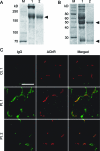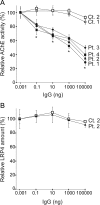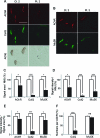Anti-MuSK autoantibodies block binding of collagen Q to MuSK
- PMID: 22013178
- PMCID: PMC3233209
- DOI: 10.1212/WNL.0b013e318237f660
Anti-MuSK autoantibodies block binding of collagen Q to MuSK
Abstract
Objective: Muscle-specific receptor tyrosine kinase (MuSK) antibody-positive myasthenia gravis (MG) accounts for 5%-15% of autoimmune MG. MuSK mediates the agrin-signaling pathway and also anchors the collagenic tail subunit (ColQ) of acetylcholinesterase (AChE). The exact molecular target of MuSK-immunoglobulin G (IgG), however, remains elusive. As acetylcholine receptor (AChR) deficiency is typically mild and as cholinesterase inhibitors are generally ineffective, we asked if MuSK-IgG interferes with binding of ColQ to MuSK.
Methods: We used 3 assays: in vitro overlay of the human ColQ-tailed AChE to muscle sections of Colq-/- mice; in vitro plate-binding assay to quantitate binding of MuSK to ColQ and to LRP4; and passive transfer of MuSK-IgG to mice.
Results: The in vitro overlay assay revealed that MuSK-IgG blocks binding of ColQ to the neuromuscular junction. The in vitro plate-binding assay showed that MuSK-IgG exerts a dose-dependent block of MuSK binding to ColQ by but not to LRP4. Passive transfer of MuSK-IgG to mice reduced the size and density of ColQ to ∼10% of controls and had a lesser effect on the size and density of AChR and MuSK.
Conclusions: As lack of ColQ compromises agrin-mediated AChR clustering in Colq-/- mice, a similar mechanism may lead to AChR deficiency in MuSK-MG patients. Our experiments also predict partial AChE deficiency in MuSK-MG patients, but AChE is not reduced in biopsied NMJs. In humans, binding of ColQ to MuSK may be dispensable for clustering ColQ, but is required for facilitating AChR clustering. Further studies will be required to elucidate the basis of this paradox.
Figures




Comment in
-
Myasthenia gravis with antibodies to MuSK: another step toward solving mystery?Neurology. 2011 Nov 15;77(20):1783-4. doi: 10.1212/WNL.0b013e3182377fa6. Epub 2011 Oct 19. Neurology. 2011. PMID: 22013184 No abstract available.
Similar articles
-
[Anti-MuSK antibodies in myasthenia gravis block binding of collagen Q to MuSK].Rinsho Shinkeigaku. 2012;52(11):1306-8. doi: 10.5692/clinicalneurol.52.1306. Rinsho Shinkeigaku. 2012. PMID: 23196600 Japanese.
-
Collagen Q and anti-MuSK autoantibody competitively suppress agrin/LRP4/MuSK signaling.Sci Rep. 2015 Sep 10;5:13928. doi: 10.1038/srep13928. Sci Rep. 2015. PMID: 26355076 Free PMC article.
-
Specific binding of collagen Q to the neuromuscular junction is exploited to cure congenital myasthenia and to explore bases of myasthenia gravis.Chem Biol Interact. 2013 Mar 25;203(1):335-40. doi: 10.1016/j.cbi.2012.08.020. Epub 2012 Sep 8. Chem Biol Interact. 2013. PMID: 22981737 Free PMC article.
-
Roles of collagen Q in MuSK antibody-positive myasthenia gravis.Chem Biol Interact. 2016 Nov 25;259(Pt B):266-270. doi: 10.1016/j.cbi.2016.04.019. Epub 2016 Apr 24. Chem Biol Interact. 2016. PMID: 27119269 Review.
-
Collagen Q is a key player for developing rational therapy for congenital myasthenia and for dissecting the mechanisms of anti-MuSK myasthenia gravis.J Mol Neurosci. 2014 Jul;53(3):359-61. doi: 10.1007/s12031-013-0170-x. J Mol Neurosci. 2014. PMID: 24234034 Review.
Cited by
-
Pyridostigmine but not 3,4-diaminopyridine exacerbates ACh receptor loss and myasthenia induced in mice by muscle-specific kinase autoantibody.J Physiol. 2013 May 15;591(10):2747-62. doi: 10.1113/jphysiol.2013.251827. Epub 2013 Feb 25. J Physiol. 2013. PMID: 23440963 Free PMC article.
-
Animal models of antimuscle-specific kinase myasthenia.Ann N Y Acad Sci. 2012 Dec;1274:140-7. doi: 10.1111/j.1749-6632.2012.06782.x. Ann N Y Acad Sci. 2012. PMID: 23252909 Free PMC article.
-
Characterization of LRP4/Agrin Antibodies From a Patient With Myasthenia Gravis.Neurology. 2021 Sep 7;97(10):e975-e987. doi: 10.1212/WNL.0000000000012463. Epub 2021 Jul 7. Neurology. 2021. PMID: 34233932 Free PMC article.
-
Muscle autoantibodies in myasthenia gravis: beyond diagnosis?Expert Rev Clin Immunol. 2012 Jul;8(5):427-38. doi: 10.1586/eci.12.34. Expert Rev Clin Immunol. 2012. PMID: 22882218 Free PMC article. Review.
-
Characterization of CD4 and CD8 T cell responses in MuSK myasthenia gravis.J Autoimmun. 2014 Aug;52:130-8. doi: 10.1016/j.jaut.2013.12.005. Epub 2013 Dec 28. J Autoimmun. 2014. PMID: 24378287 Free PMC article.
References
-
- Dechiara TM, Bowen DC, Valenzuela DM, et al. The receptor tyrosine kinase MuSK is required for neuromuscular junction formation in vivo. Cell 1996;85:501–512 - PubMed
-
- Okada K, Inoue A, Okada M, et al. The muscle protein Dok-7 is essential for neuromuscular synaptogenesis. Science 2006;312:1802–1805 - PubMed
Publication types
MeSH terms
Substances
LinkOut - more resources
Full Text Sources
Other Literature Sources
Research Materials
Miscellaneous
